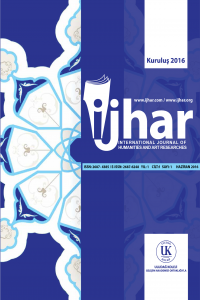Öz
Gotik mimari ilk olarak 1140 yıllarında Fransa’da doğmuştur. Paris’te uzun, aydınlık ve daha hacimli kiliselerin inşasında kullanılmıştır. Gotik mimari Ortaçağ’da sıklıkla karşılaşılan karanlık, ilkel ve soğuk mimariden sonra aydınlık, hoş ve ferah yapılar inşa edilmesini sağlamıştır. Gotik mimarinin karakteristik özelliklerinden biri ağırlıkları yaymayı sağlayan dayanma kemerleridir.Bu kemerler ağırlığın yayılmasının yanı sıra söz konusu eserlere dekoratif ve
estetik görünüm kazandırmıştır.Bu görünümdeki süslemeler ile gökyüzüne ulaşan yapılar inşa edilmiştir. Bu nedenle
gotik mimari eserleri oldukça uzundur. Buna en iyi örnekler katedraller ve kiliseler verilebilir.
Gotik Mimari ile birlikte yapılar klasik olmaktan çıkmış, aynı zamanda estetik ve güzel olmaları da sağlanmıştır. Gotik mimari eserlere örnek olarak şunlar verilebilir: Fransa’da Notre Dame Katedrali, Amiens Katedrali, Arras Town Hall, Strasbourg Katedrali, İngiltere’de Salisbury Katedrali, Westminster
Abbey, Canterbury Katedrali, İtalya’da Milano Katedrali,
Siena Katedrali, Castel Del Monte, Polonya’da Malbork Kalesi, Frombork Katedrali, İspanya’da Burgos Katedrali, Seville Katedrali, Çek Cumhuriyeti’nde Prague Kalesi, Prag’daki Charles Bridge, Belçika’da Bruges City Hall, Brussels Town Hall, Danimarka’da Roskilde Katedrali, Almanya’da Aachen Katedrali, St.Martin’s Kilisesi.
Gotik eserlerin iç ve dış süslemeleri ince işçilik ürünüdür. Gotik eserler yüksektir ve dikey düzlemdedir. Gotik eserlerin pencereleri genellikle zengin vitraylarla süslenmiştir. Pencerelerin süslemelerinde geometrik desenler kullanılarak matematikten faydalanılmıştır. Dolayısıyla matematik ve sanat iç içedir.
Matematik, sayı ve çoklukların yapılarını, özelliklerini
ve aralarındaki ilişkiyi inceleyen, analiz, cebir, istatistik, geometri gibi dallara ayrılan bir bilimdir. Sanat ise, duygu, düşünce, tasarım, güzellik ve estetiğin anlatımında kullanılan yöntemlerin tamamıdır. Araştırmacıların çoğu matematik ve sanatın birbirinden etkilendiği konusunda hemfikirdir. George Polya’nın “Matematik problem çözme sanatıdır.” tanımı sanatla matematiğin yakından ilişkisini gözler önüne serer. Polya burada matematiğin bir sanat olduğunu düşünür. Aslında problem çözme de sanatını icra eden bir sanatçının eserini ortaya koyması gibi bir matematikçinin düşüncelerini ortaya koymasıdır. Eski gotik eserlerde matematik ve sanatın ilişkisi oldukça net olarak görülmektedir.
Bu çalışmanın amacı Gotik eserlerde bulunan üçlü
yonca motifinin analitik düzlemde incelenmesidir.Önceki çalışmalardaGotik eserlerdeki üçlü, dörtlü, beşli, yonca biçimindeki pencereler incelenmiş ancak analitik düzlemde incelenerek denklemleri oluşturulmamıştır. Üç yapraklı yoncanın analitik düzlemde incelenmesi bir ilktir. Dolayısıyla bu çalışmada, gotik mimaride yonca motifleri incelenerek üçlü yonca motifinin denklemi analitik düzlemde oluşturulmaya çalışılmıştır.Sonraki çalışmalarda dörtlü ve beşli yonca motiflerin incelenmesi hedeflenmektedir.
Anahtar Kelimeler
Gotik eserler matematiktesanat üçlü yonca kilise pencere süslemeleri
Kaynakça
- • Hickman, R. ve Huckstep, P. (2003). Art and Mathematics inEducation.TheJournalofAestheticEducation,37(1), 1-12.
- • Çağlarca, S., ALTIN ORAN, sayfa 48, İnkilap Kitapevi, 1997, ISBN 975-10-1199-X-97-34-Y-0051-0468
- • Duru, A. ve İşleyen, T. (2005). Matematik ve Sanat.Kazım Karabekir Eğitim Fakültesi Dergisi, 11, 479-491
- • Hickman R.ve HuckstepP.(2003), Art and Mathematics in Education”, The Journal of Aesthetic Education, Volume 37, Number 1, Spring, pp. 1-12 ,
- • IşıkhanU.,GökçeT.veÇağlaT.(2013)“IsitPossibleto Design a Math-Art Instructional Practice? Cases of Pre-service Teachers”,Kuramsal Eğitimbilim Dergisi, 6(4), 455-476
- • Hardy, H.G. A (2005) Mathematician’s Apology. University of Alberta Mathematical Sciences Society, Available on the World Wide Web athttp://www.math.ualberta.ca/mss/
- • King, J. P (2006). Matematik Sanatı. Ankara: Tübitak Popüler Bilim Kitapları, 17. Baskı s. II, 42, 72, 981.
- • Sven Havemann&Dieter W.Fellner, (2003) Generative Parametric Design of Gotic Window Tracery Technical Report TUBS-CG—10
- • Maths in Art and Atchitecture, Comenius, “Why Maths?”, 2012-2014, Begium-Ireland-Italy-Poland-Portugal-Spain. • http://muse.jhu.edu/journals/jae/summary/ v037/37.1hickman.htmladresinden 6 Kasım 2015 tarihinde temin edilmiştir.
- • Resim 1. George Edmund caddesindeki TODDINGTON, St. Andrew Kilisesi (1824-81).
- • http://www.english-church architecture.net/ gloucestershire/toddington/toddington.htm adresinden 6 Kasım 2015 tarihinde temin edilmiştir.
Öz
Gothic architecture has been worked in France in 1140. It has been used in the construction of long, bright and more voluminous churches in Paris. Gothic architecture provided constructing bright, pretty and spacious buildings after cold and primitive architecture which encountered at Middle Age. One of the characteristics of Gothic architecture is flying buttress that allows the spreading weights. These flying buttresses were gained decorative and aesthetic appearance to the mentioned arts as well as spreading the weight. With these decorations, extraordinary buildings were built which reached to the sky. Therefore, works of Gothic architecture are quite long. Cathedrals and churches can be the best examples of these structures.
The buildings weren’t classic anymore with Gothic architecture, and also it was provided to be aesthetic and nice. Some examples of Gothic architecture are: Notre Dame Cathedral, Amiens Cathedral, Arras Town Hall, Strasbourg Cathedral in France, Salisbury Cathedral, Westminster Abbey, Canterbury Cathedral in England, Cathedral of Milan, Siena Cathedral, Castel Del Monte in Italy, Malbork Castle, Frombork Cathedral in Poland, Burgos Cathedral, Seville Cathedral in Spain, Prague Castle, the Charles Bridge in Prague in the Czech Republic, Bruges City Hall, Brussels Town Hall in Belgium, Roskilde Cathedral in Denmark, Aachen Cathedral, St.Martin's Church in Germany.
Interior and exterior decoration of the Gothic artifacts is a fine craftsmanship products. The mentioned artifacts are usually decorated with rich stained glass windows. It has been benefited from the mathematical and geometric patterns on the decorations of the windows. Therefore, mathematics and art are intertwined.
Mathematics is a science which examines such as the relationship among the structures and the properties of numbers and multiplicity calculus, algebra, statistics and geometry. On the other hand, art is a method which is used for defining feelings, thoughts, design, beauty and aesthetic. Most of the researchers agree that mathematics and art influenced by each other. Geoerge Polya’s definition, “Mathematics is an art of problem solving.”, reveals the closed relationship between mathematics and art. At this point, Polya thinks that mathematics is an art. In fact, problem solving is a manifesting of the ideas for a mathematician as putting of the art for an artist who pursues his/her art. For the old gothic arts, the relationship between mathematics and art is seen clearly.
The aim of this study is to examine the trefoil design on Gothic arts in the analytical plane. On the previous studies, the windows of which shapes are trio, quartet and quintet on Gothic arts examined, but they weren’t examined in the analytical plane and their equations weren’t generated. It is the first time for the trefoil to examine in the analytical plane. Therefore, in this study, the clover designs on Gothic architecture were tried to be examined and to be generated the equation of the mentioned design. In the post studies, it is aimed for the design of quartet and quintet to examine.
Anahtar Kelimeler
Gothic artworks Art in Mathematics triple clover church window decorations
Kaynakça
- • Hickman, R. ve Huckstep, P. (2003). Art and Mathematics inEducation.TheJournalofAestheticEducation,37(1), 1-12.
- • Çağlarca, S., ALTIN ORAN, sayfa 48, İnkilap Kitapevi, 1997, ISBN 975-10-1199-X-97-34-Y-0051-0468
- • Duru, A. ve İşleyen, T. (2005). Matematik ve Sanat.Kazım Karabekir Eğitim Fakültesi Dergisi, 11, 479-491
- • Hickman R.ve HuckstepP.(2003), Art and Mathematics in Education”, The Journal of Aesthetic Education, Volume 37, Number 1, Spring, pp. 1-12 ,
- • IşıkhanU.,GökçeT.veÇağlaT.(2013)“IsitPossibleto Design a Math-Art Instructional Practice? Cases of Pre-service Teachers”,Kuramsal Eğitimbilim Dergisi, 6(4), 455-476
- • Hardy, H.G. A (2005) Mathematician’s Apology. University of Alberta Mathematical Sciences Society, Available on the World Wide Web athttp://www.math.ualberta.ca/mss/
- • King, J. P (2006). Matematik Sanatı. Ankara: Tübitak Popüler Bilim Kitapları, 17. Baskı s. II, 42, 72, 981.
- • Sven Havemann&Dieter W.Fellner, (2003) Generative Parametric Design of Gotic Window Tracery Technical Report TUBS-CG—10
- • Maths in Art and Atchitecture, Comenius, “Why Maths?”, 2012-2014, Begium-Ireland-Italy-Poland-Portugal-Spain. • http://muse.jhu.edu/journals/jae/summary/ v037/37.1hickman.htmladresinden 6 Kasım 2015 tarihinde temin edilmiştir.
- • Resim 1. George Edmund caddesindeki TODDINGTON, St. Andrew Kilisesi (1824-81).
- • http://www.english-church architecture.net/ gloucestershire/toddington/toddington.htm adresinden 6 Kasım 2015 tarihinde temin edilmiştir.
Ayrıntılar
| Birincil Dil | Türkçe |
|---|---|
| Bölüm | Araştırma Makaleleri |
| Yazarlar | |
| Yayımlanma Tarihi | 20 Haziran 2016 |
| Gönderilme Tarihi | 4 Nisan 2016 |
| Kabul Tarihi | 22 Ocak 2020 |
| Yayımlandığı Sayı | Yıl 2016 Cilt: 1 Sayı: 1 |









